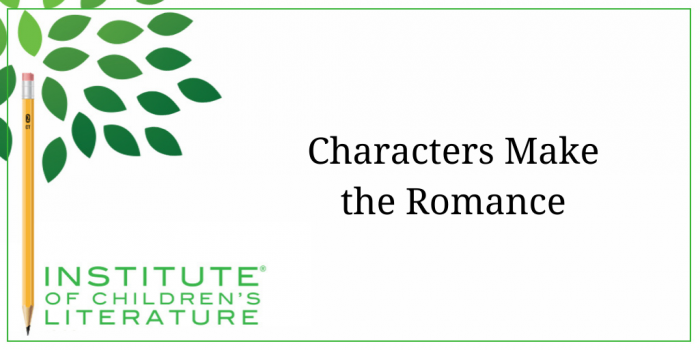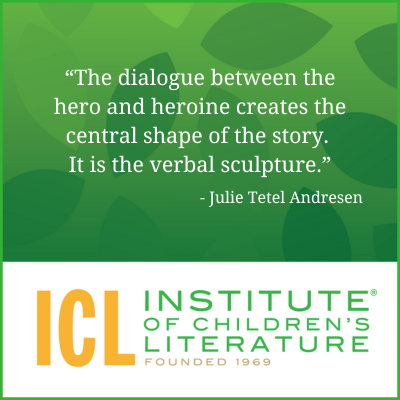1000 N. West Street #1200, Wilmington, DE 19801
© 2024 Direct Learning Systems, Inc. All rights reserved.

With romance such an important element of YA novels, it can be easy to focus all the attention on creating the main character, only to give the second romantic lead less attention (and much of it focused on looks). But all the characters in your novel need to be believable and multidimensional. They need to have their own likes and dislikes, challenges and goals before the romance begins. You may be able to craft a few walk-on characters who aren’t fully fleshed out, but your romantic leads must be complex. For one thing, it will allow you to craft more believable dialogue when the characters themselves have depth.
In most romance novels for adults, the viewpoint shifts between the romantic leads, but young adult novels most often (though not always) stay completely in the viewpoint of the main character. This means readers must especially connect with the protagonist so give them something to allow that connection.

Since virtually all YA novels have a coming-of-age element, your protagonist will be learning about himself or herself, so certain traits will nearly always be present: uncertainty, unsettledness, worry about the future. These traits aren’t always acknowledged by the protagonist (who may see himself or herself as confident and unshakable) but should be clear to the reader. YA characters often do not understand themselves nearly as well as they believe they do.
Keep in mind that the romance may not be the focal point for a YA novel. In fact, the plot may be about something else entirely, but as the protagonist deals with the challenges inherent in the plot, the romance blooms alongside that primary challenge. The romance is usually a subplot rather than the main plot, but it should weave through the story and support the actual plot goal of the story. Perhaps the journey of plot challenges met together leads to romance. Or perhaps the fact that the two characters begin this romantic relationship creates its own challenge. Perhaps the budding relationship smooths one challenge. All sorts of possibilities are available for making the romantic subplot important to the main plot, even if it isn’t the main plot.
Though YA novels tend to be filled with uncertainty as characters are struggling to solve a difficult challenge and negotiate the world of near-adulthood, the writer doesn’t necessarily need to have the characters struggle at every step of the blossoming romance. One or both of the people in the romance may be totally certain that the relationship is meant to be. The romance element doesn’t have to be a tentative thing for either or both of them, but it should hit some rough spots along the way. Romance is rarely smooth, not if the reader is meant to believe in it. One thing that should be true of both your protagonist and your romantic co-lead: imperfection. Readers need to be rooting for the characters and their success. Readers need to like the characters, and it’s hard to truly like perfect people.
One thing readers will expect to see between these two people is chemistry. In a novel, chemistry is demonstrated by the interactions between the people. The characters will be giving one another cues. One element of this might be banter. Readers love banter, especially when it’s funny. Banter can keep the romance light while showing the reader that it exists. Often some of our favorite moments in romantic movies or romantic novels feature clever banter.
Banter is a kind of conversational give-and-take. Banter can look like an argument, because it has an element of one-upping, but it is usually playful rather than furiously angry. With that playful element, there is usually an undertone as well, which can be lighthearted or deadly serious. Banter isn’t always about something of no consequence. Through scenes of banter, the reader should get the feeling that the characters are fairly evenly matched. In a successful romance, one person doesn’t run roughshod over the other.

The best romantic characters don’t exist solely for the other person. They have needs of their own, desires of their own, and goals that have nothing to do with the other person. They have places they conflict. They aren’t built totally on the surface. They aren’t perfect, even if they are generally good. When they do something good, it must be a believable good. For instance, an unbelievable character donates all her college fund to orphans, because she knows they had desperate needs. But that is not only unlikely, it leaves the character stuck for money for college and means she’d going to have to depend on someone else for that money if she decides to go. (After all she’s not likely to make enough for college from her coffee shop job). One unbelievable gesture leads to all kinds of real-world consequences that the writer and the character shouldn’t ignore. A much more believable good might be to volunteer at an animal sanctuary on the weekends or enthusiastically taking part in a fund raiser.
Make your characters believable. Give them depth. Let their exchanges grow from the specific people they are. Let their romance do that, too, and you’ll have a romantic element that strengthens your book’s main plot and doesn’t distract from it.
With over 100 books in publication, Jan Fields writes both chapter books for children and mystery novels for adults. She’s also known for a variety of experiences teaching writing, from one session SCBWI events to lengthier Highlights Foundation workshops to these blog posts for the Institute of Children’s Literature. As a former ICL instructor, Jan enjoys equipping writers for success in whatever way she can.
1000 N. West Street #1200, Wilmington, DE 19801
© 2024 Direct Learning Systems, Inc. All rights reserved.
1000 N. West Street #1200, Wilmington, DE 19801
© 2024 Direct Learning Systems, Inc. All rights reserved.
1000 N. West Street #1200, Wilmington, DE 19801
© 2024 Direct Learning Systems, Inc. All rights reserved.
1000 N. West Street #1200, Wilmington, DE 19801
© 2024 Direct Learning Systems, Inc. All rights reserved.

1000 N. West Street #1200, Wilmington, DE 19801
© 2025 Direct Learning Systems, Inc. All rights reserved.

1000 N. West Street #1200, Wilmington, DE 19801
©2025 Direct Learning Systems, Inc. All rights reserved. Privacy Policy.
3 Comments